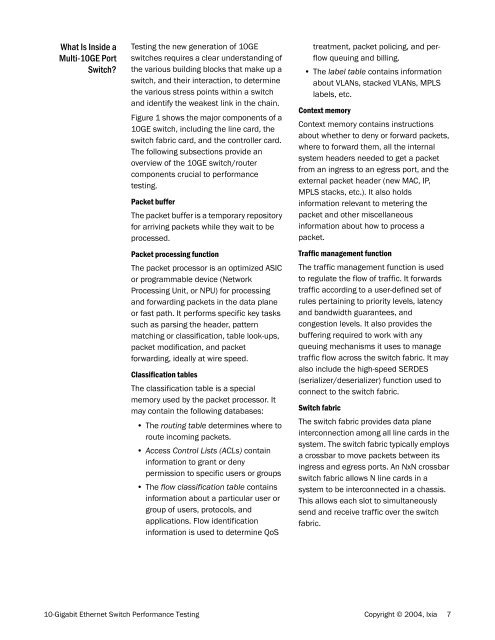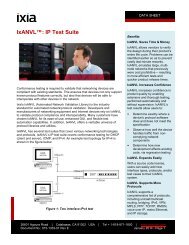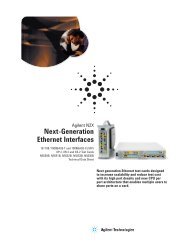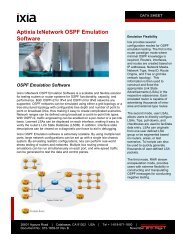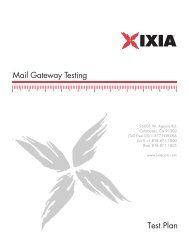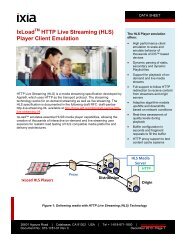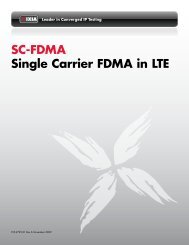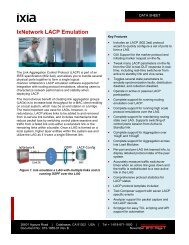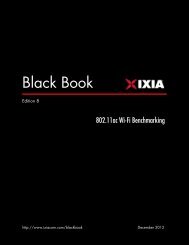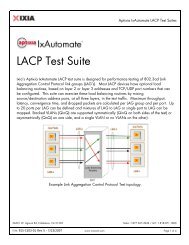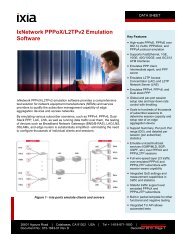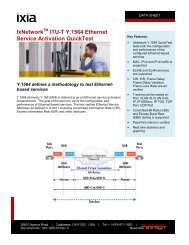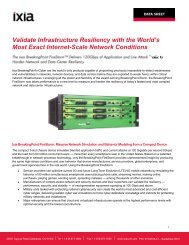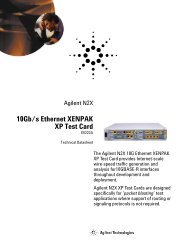10-Gigabit Ethernet Switch Performance Testing - Ixia
10-Gigabit Ethernet Switch Performance Testing - Ixia
10-Gigabit Ethernet Switch Performance Testing - Ixia
Create successful ePaper yourself
Turn your PDF publications into a flip-book with our unique Google optimized e-Paper software.
What Is Inside a<br />
Multi-<strong>10</strong>GE Port<br />
<strong>Switch</strong>?<br />
<strong>Testing</strong> the new generation of <strong>10</strong>GE<br />
switches requires a clear understanding of<br />
the various building blocks that make up a<br />
switch, and their interaction, to determine<br />
the various stress points within a switch<br />
and identify the weakest link in the chain.<br />
Figure 1 shows the major components of a<br />
<strong>10</strong>GE switch, including the line card, the<br />
switch fabric card, and the controller card.<br />
The following subsections provide an<br />
overview of the <strong>10</strong>GE switch/router<br />
components crucial to performance<br />
testing.<br />
Packet buffer<br />
The packet buffer is a temporary repository<br />
for arriving packets while they wait to be<br />
processed.<br />
Packet processing function<br />
The packet processor is an optimized ASIC<br />
or programmable device (Network<br />
Processing Unit, or NPU) for processing<br />
and forwarding packets in the data plane<br />
or fast path. It performs specific key tasks<br />
such as parsing the header, pattern<br />
matching or classification, table look-ups,<br />
packet modification, and packet<br />
forwarding, ideally at wire speed.<br />
Classification tables<br />
The classification table is a special<br />
memory used by the packet processor. It<br />
may contain the following databases:<br />
•The routing table determines where to<br />
route incoming packets.<br />
• Access Control Lists (ACLs) contain<br />
information to grant or deny<br />
permission to specific users or groups<br />
•The flow classification table contains<br />
information about a particular user or<br />
group of users, protocols, and<br />
applications. Flow identification<br />
information is used to determine QoS<br />
treatment, packet policing, and perflow<br />
queuing and billing.<br />
•The label table contains information<br />
about VLANs, stacked VLANs, MPLS<br />
labels, etc.<br />
Context memory<br />
Context memory contains instructions<br />
about whether to deny or forward packets,<br />
where to forward them, all the internal<br />
system headers needed to get a packet<br />
from an ingress to an egress port, and the<br />
external packet header (new MAC, IP,<br />
MPLS stacks, etc.). It also holds<br />
information relevant to metering the<br />
packet and other miscellaneous<br />
information about how to process a<br />
packet.<br />
Traffic management function<br />
The traffic management function is used<br />
to regulate the flow of traffic. It forwards<br />
traffic according to a user-defined set of<br />
rules pertaining to priority levels, latency<br />
and bandwidth guarantees, and<br />
congestion levels. It also provides the<br />
buffering required to work with any<br />
queuing mechanisms it uses to manage<br />
traffic flow across the switch fabric. It may<br />
also include the high-speed SERDES<br />
(serializer/deserializer) function used to<br />
connect to the switch fabric.<br />
<strong>Switch</strong> fabric<br />
The switch fabric provides data plane<br />
interconnection among all line cards in the<br />
system. The switch fabric typically employs<br />
a crossbar to move packets between its<br />
ingress and egress ports. An NxN crossbar<br />
switch fabric allows N line cards in a<br />
system to be interconnected in a chassis.<br />
This allows each slot to simultaneously<br />
send and receive traffic over the switch<br />
fabric.<br />
<strong>10</strong>-<strong>Gigabit</strong> <strong>Ethernet</strong> <strong>Switch</strong> <strong>Performance</strong> <strong>Testing</strong> Copyright © 2004, <strong>Ixia</strong> 7


